Open Source Package PHP & MySQL
- 2. PHP Language A recursive acronym: P HP H ypertext P reprocessor A scripting language designed for creating dynamic and data-driven Web pages PHP is a server-side scripting language; it is parsed and interpreted on the server side of a Web application and the resulting output is sent to the browser. (VBScript and JavaScript are mostly client-side). Designed to work with the MySQL database system, but can also connect to other database systems.
- 3. PHP Language PHP and MySQL are open-source; they can be obtained free-of-charge and the source codes are available for development. www.php.net www.mysql.com You will need to install PHP to work with your MS IIS or Apache Web server. PHP and MySQL are becoming increasingly popular in recent years because it is free of charge. Other software packages like Microsoft ASP.NET are expensive for small and medium enterprises.
- 4. A Simple PHP Example <HTML> <HEAD> <TITLE>PHP Example</TITLE> </HEAD> <BODY> <? echo "<b>Welcome</b>"; // print the string here ?> </BODY> </HTML> PHP scripts are enclosed by the <?php And ?> tags. Can simply use <? for the opening tag. All PHP statements end with a semicolon (unless it ends the closing tag on the same line) Comments can be marked by # , // or /* */ http://147.8.210.143/php/example1.php
- 5. Including Files You can include common files (like header, footer, and navigation bars) in PHP. <? include("header.inc") ?>
- 6. Variables in PHP Variable names start with the dollar sign $ You can use letters and underscore for variable names. The first character after $ cannot be a number Variable names are case-sensitive For example: <? $name = "Michael"; ?> <? $i = 1; ?>
- 7. Variables in PHP The three main types of variables in PHP: Scalar Array Object Scalar can be Integer, Double, Boolean, or String When you assign a value to a variable, its data type is also assigned.
- 8. Array Arrays can be created with integers or strings as keys. <?php $arr = array("UK" => "London", 12 => 56); echo $arr["UK"]; // London echo $arr[12]; // 56 ?>
- 9. Object Use the class statement to define a class. Use the new statement to create an object. <?php class test { function do_something() { echo "Do something"; } } $my_test = new test; $my_test->do_something(); ?>
- 10. Basic Operators Assignment/Arithmetic operators = + - * / % ++ -- += -= *= /= Comparison operators == (equal value) === (identical value and data type) != or <> < > <= >= Logical operators ! && ||
- 11. String Concatenation Same as Perl . concatenate strings .= concatenate and assign Example: $word1 = "Play"; $full_string = $word1 . "Station";
- 12. String Functions There are a lot of string functions in PHP that you can use. For example: int strlen(string str) string strtoupper(string str) string strtolower(string str) int strcmp(string str1, string str2) int strcasecmp(string str1, string str2) string strstr(string src, string target) int strpos(string src, string target [, int offset]) You can find them in the PHP manual: http://www.php.net/manual/en/
- 13. Conditions boolean variable: TRUE(1) or FALSE(0) if (EXPR) { STATEMENTS; } elseif (EXPR) { STATEMENTS; } else { STATEMENTS; } switch-case
- 14. Loops while ( EXPR ) { STATEMENTS; } do { STATEMENTS; } while (EXPR); for ( INIT_EXPR; COND_EXPR; LOOP_EXPR ) { STATEMENTS; } foreach (ARRAY as VARIABLE) { STATEMENTS; } break, continue
- 15. Alternative Syntax It is possible to write control statements and loops using the following “colon” format: <?php if ($a == 5): echo "A is equal to 5"; endif; ?>
- 16. User-defined Functions Functions can be defined using the function keyword. <?php function function_name($arg_1, $arg_2, ...) { statements; return $some_value; // optional } ?>
- 17. Mixing HTML and PHP Codes PHP codes can be easily inserted anywhere in an HTML page. You can even mix the codes together, usually to avoid writing too many “echo” statements with escape characters. <? if ($i == 1) { ?> <h2>The condition is true</h2> <center><b>$i is 1</b></center> <? } else { ?> <h2>The condition is false</h2> <center><b>$i is not 1</b></center> <? } ?> HTML PHP
- 18. Shortcut for Writing Echos Instead of writing <? echo expression ?> You can use the following shortcut <?= expression ?> This is useful for inserting expressions and variables quickly into HTML pages.
- 19. Working with HTML Forms You can easily get the variables submitted by an HTML form using the following (assume the form input is called “name”: $_POST['name'] // post method $_GET['name'] // get method $name /* easier, but Register Globals must be set to ON in PHP config */
- 20. Working with HTML Forms It is common to put the form and the results of different requests in the same file. <HTML> <HEAD><TITLE>PHP FORM TEST</TITLE></HEAD> <BODY> <? if (!isset($name) || $name == "") { ?> <FORM METHOD="post"> Your name: <INPUT TYPE="text" NAME="name"> Your age: <INPUT TYPE="text" NAME="age"> <INPUT TYPE="submit"> </FORM> <? } else { echo "Your name is $name<BR>"; echo "Your age is $age"; } ?> </BODY> </HTML> If name is empty or not defined, then show the form If name is not empty, i.e., when the user has entered something, then show the results http://localhost/php/example2.php
- 21. PHP and MySQL PHP is designed to work with the MySQL database. However, it can also connect to other database systems such as Oracle, Sybase, etc., using ODBC.
- 22. Example <HTML> <BODY> <?php $db = mysql_connect("localhost", "root“,””); mysql_select_db("mydb " , $db); $result = mysql_query("SELECT * FROM employees",$db); printf("First Name: %s<br>\n", mysql_result($result,0,"first")); printf("Last Name: %s<br>\n", mysql_result($result,0,"last")); printf("Address: %s<br>\n", mysql_result($result,0,"address")); printf("Position: %s<br>\n",mysql_result($result,0,"position")); mysql_free_result($result); mysql_close($db); ?> </BODY> </HTML>
- 23. Useful PHP Functions for MySQL mysql_connect(host, username [,password]); Connects to a MySQL server on the specified host using the given username and/or password. Returns a MySQL link identifier on success, or FALSE on failure. mysql_select_db(db_name [,resource]) Selects a database from the database server.
- 24. Useful PHP Functions for MySQL mysql_query(SQL, resource); Sends the specified SQL query to the database specified by the resource identifier. The retrieved data are returned by the function as a MySQL result set. mysql_result(result, row [,field]); Returns the contents of one cell from a MySQL result set. The field argument can be the field name or the field’s offset. mysql_fetch_array(result [,result_type]) Fetch a result row as an associative array, a numeric array, or both. The result type can take the constants MYSQL_ASSOC, MYSQL_NUM, and MYSQL_BOTH.
- 25. Useful PHP Functions for MySQL mysql_free_result(result) Frees the result set mysql_close(resource) Closes the connection to the database.
- 26. Error Handling If there is error in the database connection, you can terminate the current script by using the die function. For example: $db = mysql_connect("localhost", "root“, “”) or die("Could not connect : " . mysql_error()); mysql_select_db("my_database") or die("Could not select database"); $result = mysql_query($query) or die("Query failed");
- 27. Example: Looping through the Cells <?php /* Connecting, selecting database */ $link = mysql_connect("mysql_host", "mysql_user", mysql_password") or die("Could not connect : " . mysql_error()); echo "Connected successfully"; mysql_select_db("my_database") or die("Could not select database"); /* Performing SQL query */ $query = "SELECT * FROM my_table"; $result = mysql_query($query) or die("Query failed : " . mysql_error()); /* Printing results in HTML */ echo "<table>\n"; while ($line = mysql_fetch_array($result, MYSQL_ASSOC)) { echo "\t<tr>\n"; foreach ($line as $col_value) { echo "\t\t<td>$col_value</td>\n"; } echo "\t</tr>\n"; } echo "</table>\n"; Loop through each row of the result set Loop through each element in a row
- 28. Example: Looping through the Cells /* Free resultset */ mysql_free_result($result); /* Closing connection */ mysql_close($link); ?>
- 29. Thank You
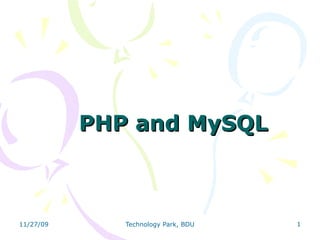




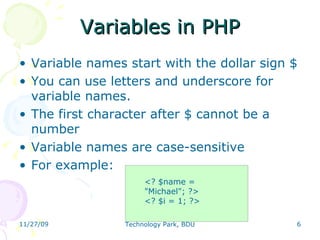

![Array Arrays can be created with integers or strings as keys. <?php $arr = array("UK" => "London", 12 => 56); echo $arr["UK"]; // London echo $arr[12]; // 56 ?>](https://image.slidesharecdn.com/open-source-package-php-mysql-1228203701094763-9/85/Open-Source-Package-PHP-MySQL-8-320.jpg)


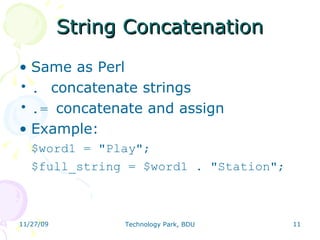
![String Functions There are a lot of string functions in PHP that you can use. For example: int strlen(string str) string strtoupper(string str) string strtolower(string str) int strcmp(string str1, string str2) int strcasecmp(string str1, string str2) string strstr(string src, string target) int strpos(string src, string target [, int offset]) You can find them in the PHP manual: http://www.php.net/manual/en/](https://image.slidesharecdn.com/open-source-package-php-mysql-1228203701094763-9/85/Open-Source-Package-PHP-MySQL-12-320.jpg)
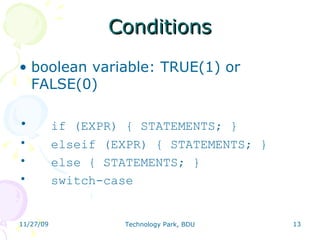




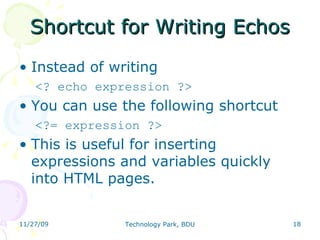
![Working with HTML Forms You can easily get the variables submitted by an HTML form using the following (assume the form input is called “name”: $_POST['name'] // post method $_GET['name'] // get method $name /* easier, but Register Globals must be set to ON in PHP config */](https://image.slidesharecdn.com/open-source-package-php-mysql-1228203701094763-9/85/Open-Source-Package-PHP-MySQL-19-320.jpg)



![Useful PHP Functions for MySQL mysql_connect(host, username [,password]); Connects to a MySQL server on the specified host using the given username and/or password. Returns a MySQL link identifier on success, or FALSE on failure. mysql_select_db(db_name [,resource]) Selects a database from the database server.](https://image.slidesharecdn.com/open-source-package-php-mysql-1228203701094763-9/85/Open-Source-Package-PHP-MySQL-23-320.jpg)
![Useful PHP Functions for MySQL mysql_query(SQL, resource); Sends the specified SQL query to the database specified by the resource identifier. The retrieved data are returned by the function as a MySQL result set. mysql_result(result, row [,field]); Returns the contents of one cell from a MySQL result set. The field argument can be the field name or the field’s offset. mysql_fetch_array(result [,result_type]) Fetch a result row as an associative array, a numeric array, or both. The result type can take the constants MYSQL_ASSOC, MYSQL_NUM, and MYSQL_BOTH.](https://image.slidesharecdn.com/open-source-package-php-mysql-1228203701094763-9/85/Open-Source-Package-PHP-MySQL-24-320.jpg)




